Applying Satellite-Based and Global Atmospheric Reanalysis Datasets to Simulate Sulphur Dioxide Plume Dispersion from Mount Nyamuragira 2006 Volcanic Eruption
Abstract
1. Introduction
2. Study Area
3. Data Sources
3.1. OMI
3.2. MERRA-2
3.3. CALIPSO
3.4. HYSPLIT Model
4. Results and Discussion
4.1. Timeseries of Observed SO2 Column Mass Densities
4.2. Spatial Distribution of SO2 over Some Period
4.3. Transport and Dispersion of SO2
4.3.1. HYSPLIT Model
4.3.2. Jet Stream
4.4. Vertical Distribution of Volcanic Aerosols
5. Conclusions
Supplementary Materials
Author Contributions
Funding
Institutional Review Board Statement
Informed Consent Statement
Data Availability Statement
Acknowledgments
Conflicts of Interest
References
- Hughes, E.J.; Sparling, L.C.; Carn, S.A.; Krueger, A.J. Using horizontal transport characteristics to infer an emission height time series of volcanic SO2. J. Geophys. Res. Atmos. 2012, 117, D18301. [Google Scholar] [CrossRef]
- Fisher, R.V. Models for pyroclastic surges and pyroclastic flows. J. Volcanol. Geotherm. Res. 1979, 6, 305–318. [Google Scholar] [CrossRef]
- Robock, A.; Oppenheimer, C. (Eds.) Volcanism and the Earth’s Atmosphere; Geophysical Monograph 139; American Geophysical Union: Washington, DC, USA, 2003; 360p. [Google Scholar]
- Paez, P.A.; Cogliati, M.G.; Caselli, A.T.; Monasterio, A.M. An analysis of volcanic SO2 and ash emissions from Copahue volcano. J. S. Am. Earth Sci. 2021, 110, 103365. [Google Scholar] [CrossRef]
- Valentine, G.A. Stratified flow in pyroclastic surges. Bull. Volcanol. 1987, 49, 616–630. [Google Scholar] [CrossRef]
- Druitt, T.; Calder, E.S.; Cole, P.; Hoblitt, R.; Loughlin, S.; Norton, G.; Ritchie, L.; Sparks, R.; Voight, B. Small-volume, highly mobile pyroclastic flows formed by rapid sedimentation from pyroclastic surges at Soufrière Hills Volcano, Montserrat: An important volcanic hazard. Geol. Soc. Lond. Mem. 2002, 21, 263–279. [Google Scholar] [CrossRef]
- Prata, A.J.; Kerkmann, J. Simultaneous retrieval of volcanic ash and SO2 using MSG-SEVIRI measurements. Geophys. Res. Lett. 2007, 34, L05813. [Google Scholar] [CrossRef]
- Liu, T.; Chan, A.W.; Abbatt, J.P. Multiphase oxidation of sulphur dioxide in aerosol particles: Implications for sulfate formation in polluted environments. Environ. Sci. Technol. 2021, 55, 4227–4242. [Google Scholar] [CrossRef] [PubMed]
- Chen, S.Y.; Chan, C.C.; Su, T.C. Particulate and gaseous pollutants on inflammation, thrombosis, and autonomic imbalance in subjects at risk for cardiovascular disease. Environ. Pollut. 2017, 223, 403–408. [Google Scholar] [CrossRef] [PubMed]
- Rodríguez-Villamizar, L.A.; Rojas-Roa, N.Y.; Fernández-Niño, J.A. Short-term joint effects of ambient air pollutants on emergency department visits for respiratory and circulatory diseases in Colombia, 2011–2014. Environ. Pollut. 2019, 248, 380–387. [Google Scholar] [CrossRef]
- Seinfeld, J.H.; Pandis, S.N. Atmospheric Chemistry and Physics: From Air Pollution to Climate Change, 3rd ed.; John Wiley & Sons: Hoboken, NJ, USA, 2016. [Google Scholar]
- Spinei, E.; Carn, S.A.; Krotkov, N.A.; Mount, G.H.; Yang, K.; Krueger, A. Validation of Ozone Monitoring Instrument SO2 measurements in the Okmok volcanic cloud over Pullman, WA, July 2008. J. Geophys. Res. Atmos. 2010, 115, D00L08. [Google Scholar] [CrossRef]
- Lovejoy, S.; Varotsos, C. Scaling regimes and linear/nonlinear responses of last millennium climate to volcanic and solar forcings. Earth Syst. Dynam. 2016, 7, 133–150. [Google Scholar] [CrossRef]
- Ukhov, A.; Mostamandi, S.; Krotkov, N.; Flemming, J.; da Silva, A.; Li, C.; Fioletov, V.; McLinden, C.; Anisimov, A.; Alshehri, Y.M.; et al. Study of SO2 Pollution in the Middle East Using MERRA-2, CAMS Data Assimilation Products, and High-Resolution WRF-Chem Simulations. J. Geophys. Res. Atmos. 2020, 125, e2019JD031993. [Google Scholar] [CrossRef]
- Shikwambana, L.; Sivakumar, V.; Xongo, K. Tracking the transport of SO2 and sulphate aerosols from the Tonga volcanic eruption to South Africa. Atmosphere 2023, 14, 1556. [Google Scholar] [CrossRef]
- Chai, T.; Crawford, A.; Stunder, B.; Pavolonis, M.J.; Draxler, R.; Stein, A. Improving volcanic ash predictions with the HYSPLIT dispersion model by assimilating MODIS satellite retrievals. Atmos. Chem. Phys. 2017, 17, 2865–2879. [Google Scholar] [CrossRef]
- Michellier, C.; Katoto, P.d.; Dramaix, M.; Nemery, B.; Kervyn, F. Respiratory health and eruptions of the Nyiragongo and Nyamulagira Volcanoes in the Democratic Republic of Congo: A time series analysis. Environ. Health 2020, 19, 62. [Google Scholar] [CrossRef]
- Li, L.; Kervyn, M.; Canters, F. Mapping the vegetation colonization on recent lava flows using spectral unmixing of moderate spatial resolution satellite images: Nyamuragira volcano, D.R. Congo. In Proceedings of the EGU General Assembly Conference Abstracts, Vienna, Austria, 27 April–2 May, 2014; p. 3773. [Google Scholar]
- Kayiranga, A.; Kurban, A.; Nahayo, L.; Ndayisaba, F. Assessing Forest cover changes in Volcanoes Parks Region of East-Central Africa using Landsat imagery. J. Environ. Prot. Sustain. Dev. 2018, 4, 16–25. [Google Scholar]
- Verbeken, J.; De Temmerman, L.; Goossens, R.; Lavreau, J.; De Maeyer, P. Classification of the vegetation in the Virunga National Park (D.R. Congo) by integrating past mission reports into Landsat-TM and Terra ASTER sensors. New Strateg. Eur. Remote Sens. 2005, 11, 11–16. [Google Scholar]
- Udahogora, M.; Yang, Z.; Nzabarinda, V.; Akbar, I.; Mindje, R.; Umwali, E.D. Comparing factors conditioning landscape change during volcanic eruption at Virunga National Park, East Africa. Appl. Ecol. Environ. Res. 2021, 19, 3789–3803. [Google Scholar] [CrossRef]
- Pouclet, A.; Bram, K. Nyiragongo and Nyamuragira: A review of volcanic activity. Bull. Volcanol. 2021, 83, 35. [Google Scholar] [CrossRef]
- Benoît, S.; Wauthier, C.; d’Oreye, N. A new map of the lava flow field of Nyamulagira (D.R. Congo) from satellite imagery. J. Afr. Earth Sci. 2010, 58, 778–786. [Google Scholar] [CrossRef]
- Head, E.M.; Shaw, A.M.; Wallace, P.J.; Sims, K.W.; Carn, S.A. Insight into volatile behavior at Nyamuragira volcano (D.R. Congo, Africa) through olivine hosted melt inclusions. Geochem. Geophys. Geosyst. 2011, 12, Q10013. [Google Scholar] [CrossRef]
- Balagizi, C.M.; Kasereka, M.M.; Cuoco, E.; Liotta, M. Rain-plume interactions at Nyiragongo and Nyamulagira volcanoes and associated rainwater hazards, East Africa. Geophys. Res. 2017, 81, 76–89. [Google Scholar] [CrossRef]
- Levelt, P.F.; van den Oord, G.H.J.; Dobber, M.R.; Malkki, A.; Visser, H.; de Vries, J.; Stammes, P.; Lundell, J.O.V.; Saari, H. The Ozone Monitoring Instrument. IEEE Trans. Geosci. Remote Sens. 2006, 44, 1093–1101. [Google Scholar] [CrossRef]
- Liu, X.; Bhartia, P.K.; Chance, K.; Spurr, R.J.D.; Kurosu, T.P. Ozone profile retrievals from the Ozone Monitoring Instrument. Atmos. Chem. Phys. 2010, 10, 2521–2537. [Google Scholar] [CrossRef]
- Kroon, M.; de Haan, J.F.; Veefkind, J.P.; Froidevaux, L.; Wang, R.; Kivi, R.; Hakkarainen, J.J. Validation of operational ozone profiles from the Ozone Monitoring Instrument. J. Geophys. Res. Atmos. 2011, 116, D18305. [Google Scholar] [CrossRef]
- Levelt, P.F.; Joiner, J.; Tamminen, J.; Veefkind, J.P.; Bhartia, P.K.; Stein Zweers, D.C.; Duncan, B.N.; Streets, D.G.; Eskes, H.; van der A, R.; et al. The Ozone Monitoring Instrument: Overview of 14 years in space. Atmos. Chem. Phys. 2018, 18, 5699–5745. [Google Scholar] [CrossRef]
- Randles, C.A.; Silva, A.M.d.; Buchard, V.; Colarco, P.R.; Darmenov, A.; Govindaraju, R.; Smirnov, A.; Holben, B.; Ferrare, R.; Hair, J.; et al. The MERRA-2 aerosol reanalysis, 1980 onward. Part I: System description and data assimilation evaluation. J. Clim. 2017, 30, 6823–6850. [Google Scholar] [CrossRef]
- Buchard, V.; Randles, C.A.; da Silva, A.M.; Darmenov, A.; Colarco, P.R.; Govindaraju, R.; Ferrare, R.; Hair, J.; Beyersdorf, A.J.; Ziemba, L.D.; et al. The MERRA-2 aerosol reanalysis, 1980 onward. Part II: Evaluation and case studies. J. Clim. 2017, 30, 6851–6872. [Google Scholar] [CrossRef] [PubMed]
- Gelaro, R.; McCarty, W.; Suárez, M.J.; Todling, R.; Molod, A.; Takacs, L.; Randles, C.A.; Darmenov, A.; Bosilovich, M.G.; Reichle, R.; et al. The Modern-Era Retrospective Analysis for Research and Applications, Version 2 (MERRA-2). J. Clim. 2017, 30, 5419–5454. [Google Scholar] [CrossRef] [PubMed]
- Winker, D.M.; Pelon, J.; Coakley, J.A.; Ackerman, S.A.; Charlson, R.J.; Colarco, P.R.; Flamant, P.; Fu, Q.; Hoff, R.M.; Kittaka, C.; et al. The CALIPSO mission: A global 3D view of aerosols and clouds. Bull. Am. Meteorol. Soc. 2010, 91, 1211–1230. [Google Scholar] [CrossRef]
- Hunt, W.H.; Winker, D.M.; Vaughan, M.A.; Powell, K.A.; Lucker, P.L.; Weimer, C. CALIPSO Lidar description and performance assessment. J. Atmos. Ocean. Technol. 2009, 26, 1214–1228. [Google Scholar] [CrossRef]
- Vaughan, M.A.; Powell, K.A.; Kuehn, R.E.; Young, S.A.; Winker, D.M.; Hostetler, C.A.; Hunt, W.H.; Liu, Z.Y.; McGill, M.J.; Getzewich, B.J. Fully automated detection of cloud and aerosol layers in the CALIPSO lidar measurements. J. Atmos. Ocean. Technol. 2009, 26, 2034–2050. [Google Scholar] [CrossRef]
- Tackett, J.L.; Winker, D.M.; Getzewich, B.J.; Vaughan, M.A.; Young, S.A.; Kar, J. CALIPSO lidar level 3 aerosol profile product: Version 3 algorithm design. Atmos. Meas. Tech. 2018, 11, 4129–4152. [Google Scholar] [CrossRef] [PubMed]
- Zeng, S.; Vaughan, M.; Liu, Z.; Trepte, C.; Kar, J.; Omar, A.; Winker, D.; Lucker, P.; Hu, Y.; Getzewich, B.; et al. Application of high-dimensional fuzzy K-means cluster analysis to CALIOP/CALIPSO version 4.1 cloud-aerosol discrimination. Atmos. Meas. Tech. 2019, 12, 2261–2285. [Google Scholar] [CrossRef]
- Nawaz, H.; Tariq, S.; Haq, Z.u.; Mehmood, U. Identifying the natural and anthropogenic drivers of absorbing aerosols using OMI data and HYSPLIT model over South Asia. Air Qual. Atmos. Health 2023, 16, 2553–2577. [Google Scholar] [CrossRef]
- Draxler, R.R.; Hess, G.D. An Overview of the HYSPLIT_4 Modeling System of Trajectories, Dispersion, and Deposition. Aust. Meteorol. Mag. 1998, 47, 295–308. [Google Scholar]
- Stein, A.F.; Draxler, R.R.; Rolph, G.D.; Stunder, B.J.B.; Cohen, M.D.; Ngan, F. NOAA’s HYSPLIT atmospheric transport and dispersion modeling system. Bull. Am. Meteorol. Soc. 2015, 96, 2059–2077. [Google Scholar] [CrossRef]
- Rolph, G.; Stein, A.; Stunder, B. Real-time Environmental Applications and Display sYstem: READY. Environ. Model. Softw. 2017, 95, 210–228. [Google Scholar] [CrossRef]
- Vergados, P.; Mannucci, A.J.; Ao, C.O.; Verkhoglyadova, O.; Iijima, B. Comparisons of the tropospheric specific humidity from GPS radio occultations with ERA-Interim, NASA MERRA, and AIRS data. Atmos. Meas. Tech. 2018, 11, 1193–1206. [Google Scholar] [CrossRef]
- Tenny, K.M.; Cooper, J.S. Ideal Gas Behavior; StatPearls Publishing: Treasure Island, FL, USA, 2017. [Google Scholar]
- Kauzmann, W. Thermodynamics and Kinetic Theory; Courier Corporation: North Chelmsford, MA, USA, 2012. [Google Scholar]
- Loeb, L.B. The Kinetic Theory of Gases; Being a Text and Reference Book Whose Purpose Is to Combine the Classical Deductions with Recent Experimental Advances in a Convenient form for Student and Investigator; Dover Publications: Mineola, NY, USA, 2004. [Google Scholar]
- Heaviside, C.; Witham, C.; Vardoulakis, S. Potential health impacts from sulphur dioxide and sulphate exposure in the UK resulting from an Icelandic effusive volcanic eruption. Sci. Total Environ. 2021, 774, 145549. [Google Scholar] [CrossRef] [PubMed]
- Stewart, C.; Damby, D.E.; Horwell, C.J.; Elias, T.; Ilyinskaya, E.; Tomašek, I.; Longo, B.M.; Schmidt, A.; Carlsen, H.; Mason, E.; et al. Volcanic air pollution and human health: Recent advances and future directions. Bull. Volcanol. 2022, 84, 11. [Google Scholar] [CrossRef]
- Stendel, M.; Francis, J.; White, R.; Williams, P.D.; Woollings, T. The jet stream and climate change. In Climate Change; Elsevier: Amsterdam, The Netherlands, 2021; pp. 327–357. [Google Scholar]
- Varotsos, C. Atmospheric pollution and remote sensing: Implications for the southern hemisphere ozone hole split in 2002 and the northern mid-latitude ozone trend. Adv. Space Res. 2004, 33, 249–253. [Google Scholar] [CrossRef]
- Varotsos, C.A.; Cracknell, A.P. Remote Sensing Letters contribution to the success of the Sustainable Development Goals—UN 2030 agenda. Remote Sens. Lett. 2020, 11, 715–719. [Google Scholar] [CrossRef]
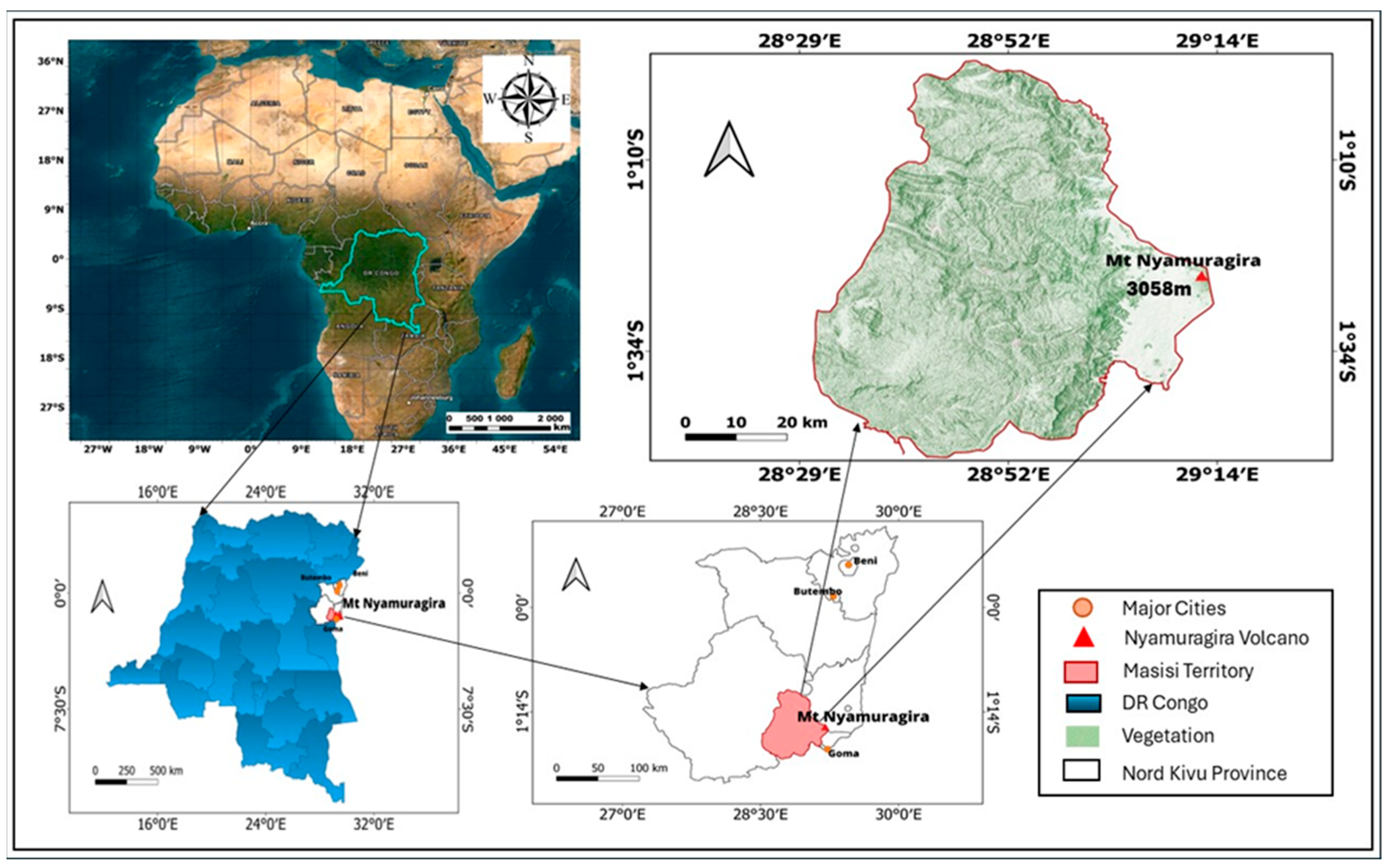
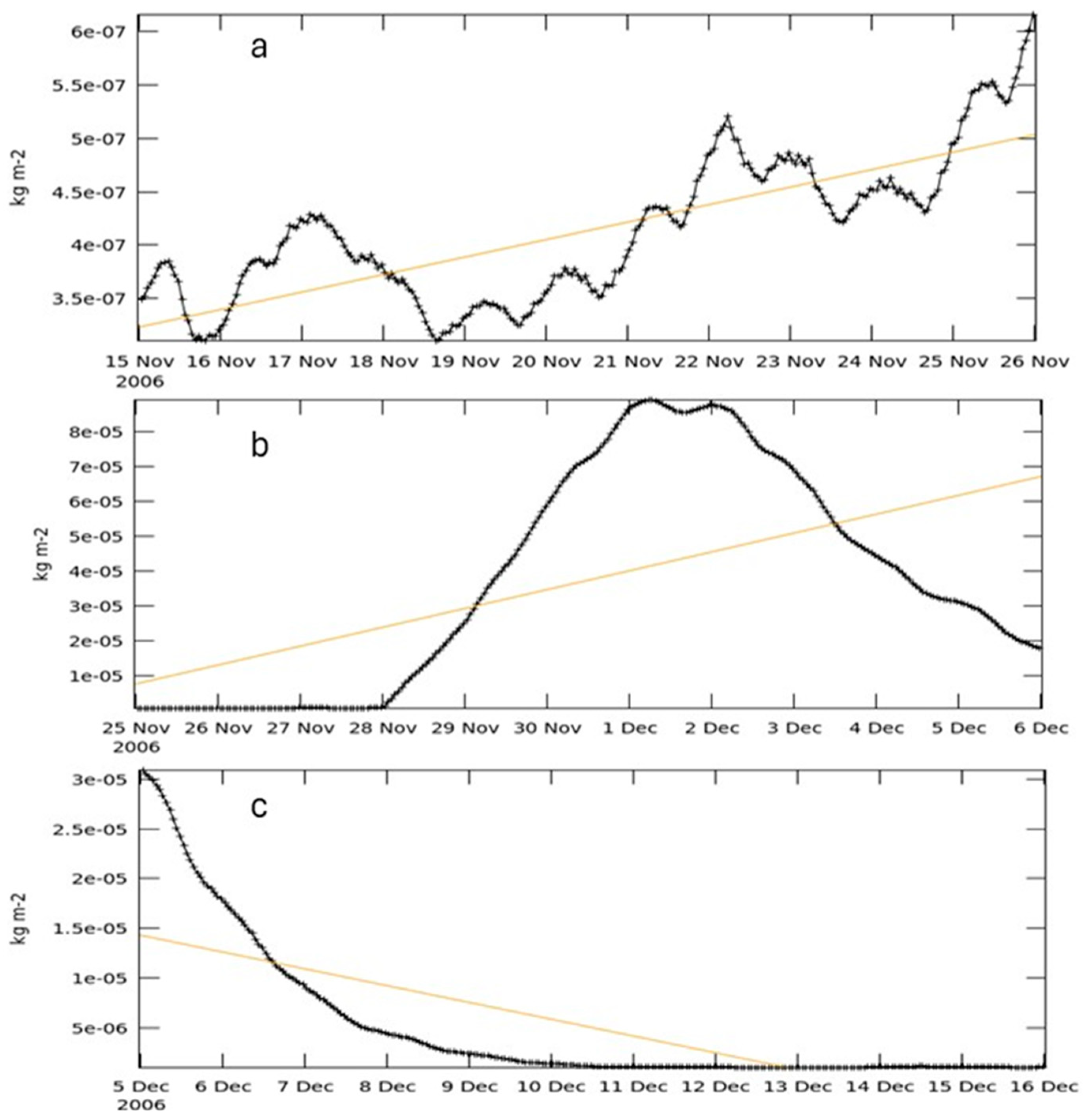
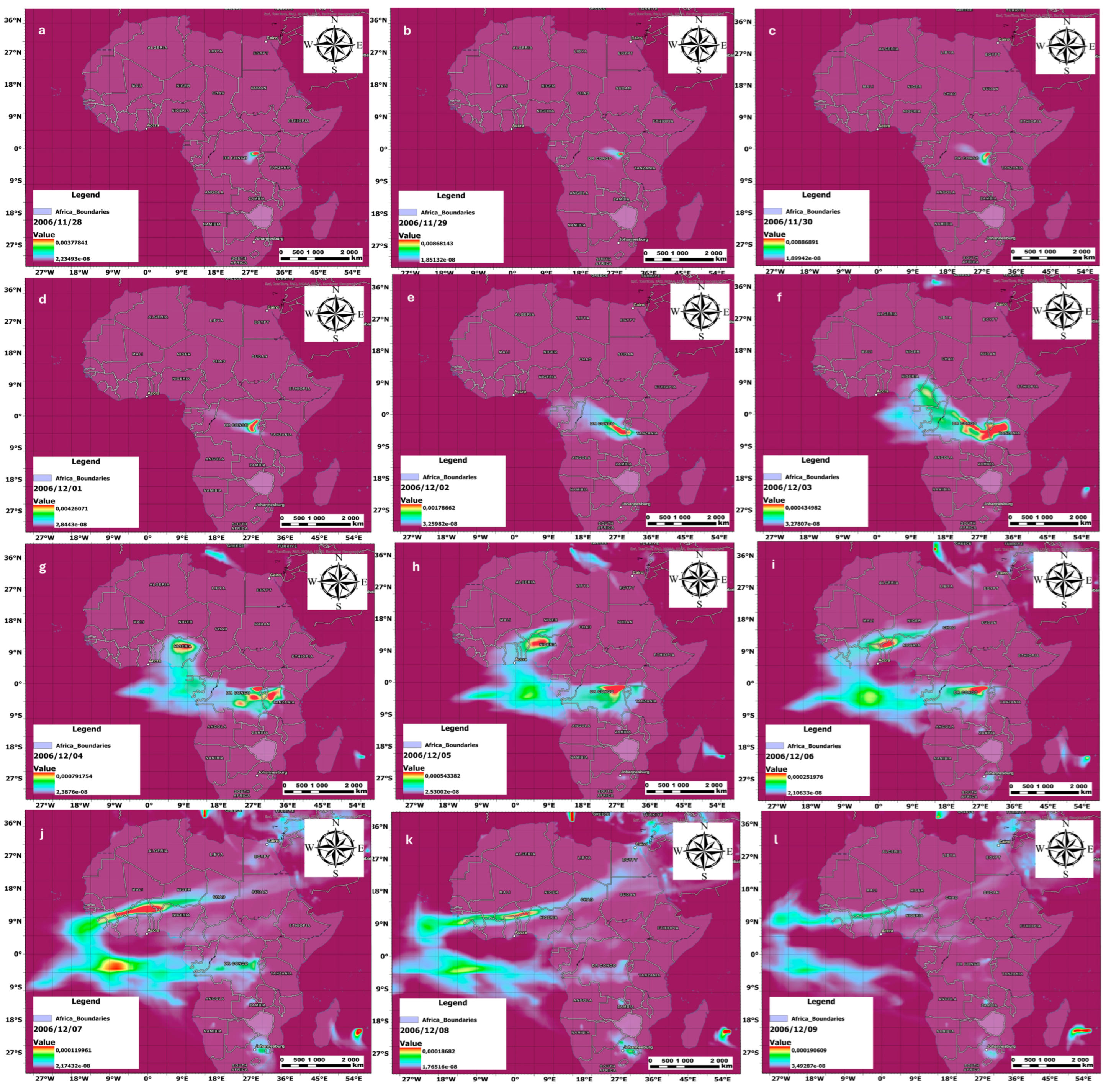
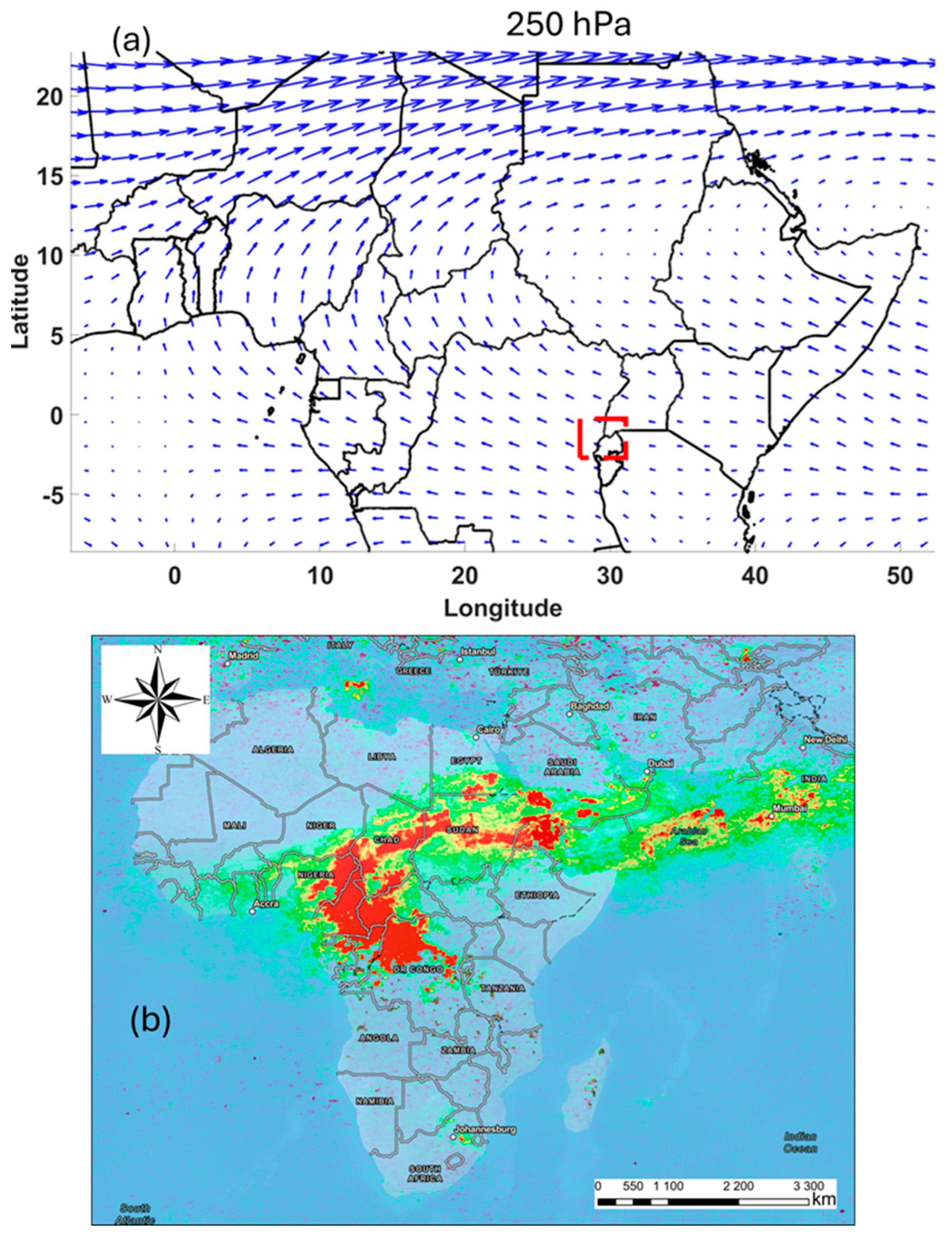
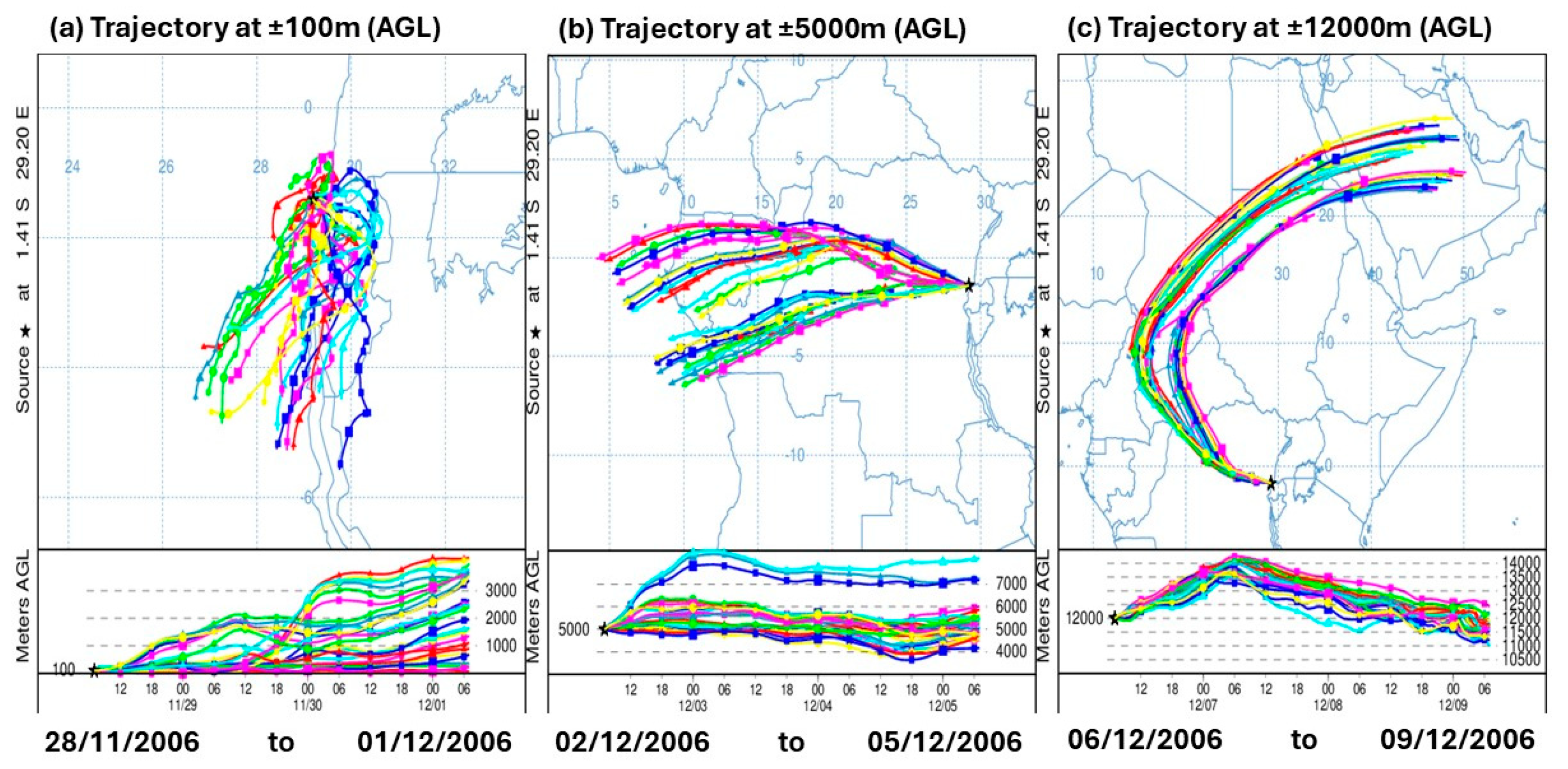
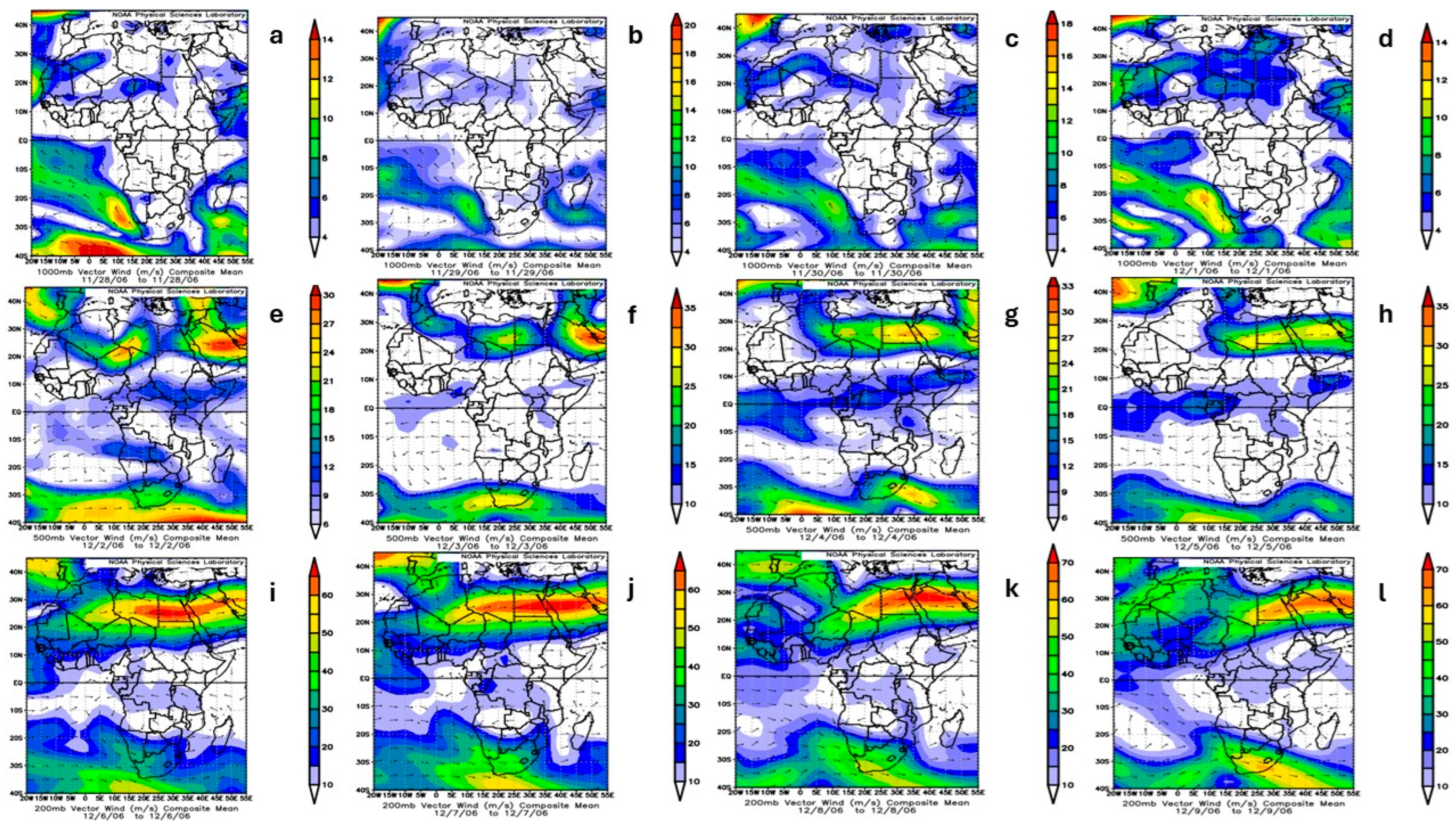

| Platform | Spatial Resolution | Product Name | Output Data |
|---|---|---|---|
| OMI | 13 km × 24 km | SO2 column density (kg/m2) | Timeseries Spatial distribution maps |
| CALIPSO | 330 m horizontal 30 m vertical | Aerosol Extinction Coefficient Aerosol subtypes | Latitude–altitude graphs |
| MERRA-2 | 0.5° × 0.625° | Wind Speed (m·s−1) | Spatial distribution maps |
| HYSPLIT model | - | 5 days forward air mass trajectories | Map showing trajectory of air masses |
Disclaimer/Publisher’s Note: The statements, opinions and data contained in all publications are solely those of the individual author(s) and contributor(s) and not of MDPI and/or the editor(s). MDPI and/or the editor(s) disclaim responsibility for any injury to people or property resulting from any ideas, methods, instructions or products referred to in the content. |
© 2025 by the authors. Licensee MDPI, Basel, Switzerland. This article is an open access article distributed under the terms and conditions of the Creative Commons Attribution (CC BY) license (https://creativecommons.org/licenses/by/4.0/).
Share and Cite
Modiba, T.; Molefe, M.; Shikwambana, L. Applying Satellite-Based and Global Atmospheric Reanalysis Datasets to Simulate Sulphur Dioxide Plume Dispersion from Mount Nyamuragira 2006 Volcanic Eruption. Earth 2025, 6, 102. https://doi.org/10.3390/earth6030102
Modiba T, Molefe M, Shikwambana L. Applying Satellite-Based and Global Atmospheric Reanalysis Datasets to Simulate Sulphur Dioxide Plume Dispersion from Mount Nyamuragira 2006 Volcanic Eruption. Earth. 2025; 6(3):102. https://doi.org/10.3390/earth6030102
Chicago/Turabian StyleModiba, Thabo, Moleboheng Molefe, and Lerato Shikwambana. 2025. "Applying Satellite-Based and Global Atmospheric Reanalysis Datasets to Simulate Sulphur Dioxide Plume Dispersion from Mount Nyamuragira 2006 Volcanic Eruption" Earth 6, no. 3: 102. https://doi.org/10.3390/earth6030102
APA StyleModiba, T., Molefe, M., & Shikwambana, L. (2025). Applying Satellite-Based and Global Atmospheric Reanalysis Datasets to Simulate Sulphur Dioxide Plume Dispersion from Mount Nyamuragira 2006 Volcanic Eruption. Earth, 6(3), 102. https://doi.org/10.3390/earth6030102






